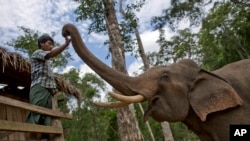Elephants have had a rich history in Myanmar, the country also known as Burma. Throughout the country’s past, the animals have been used for everything, including transportation, agriculture and warfare.
The white elephant was a symbol of power for the military that ruled the country for more than 50 years until it gave power to a civilian government in 2016.
But the survival of elephants is under threat. There are about 2,000 wild elephants left in Myanmar today, plus about 5,000 that are captive. But conservationists warn that elephants are losing their natural places to live in.
They say increased conflict with humans and the illegal sale of elephants and their parts could result in the extinction of the Asian Elephant in Myanmar.
The Ministry of Natural Resources and Environmental Conservation published the Myanmar Elephant Conservation Plan (MECAP). The plan was produced with several wildlife groups. It aims to guide policies on the survival of elephants in Myanmar for the next 100 years or more.
Anthony Lynam is a senior advisor for the Wildlife Conservation Society. He told VOA by email that the Government of Myanmar decided to ask for a study of the threats to elephants.
He added that the MECAP plan will need “bold action on the part of the government and supporting agencies for it to succeed.”
MECAP includes a series of 10-year plans and an overall strategy for elephant conservation in Myanmar.
One of the biggest threats to the survival of elephants in Myanmar is the illegal killing of the animals, especially for their skin.
“It has been argued that poaching is a…minor threat to Asian Elephants because some males and all females lack tusks,” the report said. But, the report also said that elephants are poached for meat and leather as well as for their tusks.
Christy Williams is the country director for the World Wildlife Fund, or WWF, in Myanmar. She told VOA there had been an increase in the number of elephants being killed for their skin in Myanmar in recent years.
Elephants being targeted for their skin was unusual, he said, “but then in 2016 or 2017 we started seeing that about one elephant was being killed every week.”
Williams said when WWF researchers traveled to border towns in 2016, only a few markets were selling elephant skins. But when they returned about a year later, “about 80 percent [of shops] were selling elephant skin,” he said.
One of the major difficulties in combating the illegal sale of elephant parts, said Williams, was the small staff and a lack of money. Also, many of the border towns where elephant skins are being sold are not under government control.
The plan asks for an increase in staff and for education efforts to show people that selling elephant parts is illegal.
Another problem was the increase in conflict between humans and elephants. Mark Grinley is a project manager for the non-governmental group Fauna & Flora International Myanmar. He says the elephants’ natural habitat is shrinking.
“The natural habitat is being lost,” Grinley told VOA, to large, industrial farms and to the demand for palm oil.
The effects of the increased interaction between humans and elephants has led to injuries and death for both.
Suggestions for dealing with the issue include establishing a national management plan and supporting existing elephants. Other ideas include building a warning system so that people know when elephants are nearby.
As the country of Myanmar continues to develop, the issue of elephant protection will not go away, said Grinley.
"As the forest habitat is shrinking, I’m afraid these problems are going to be more common,” he said.
I’m Dorothy Gundy. And I’m Susan Shand.
Oliver Slow reported this story for VOA News. Susan Shand adapted it for VOA Learning English. Mario Ritter was the editor.
________________________________________________________________
Words in This Story
Symbol – n. an action, object, event, etc., that expresses or represents a particular idea or quality
Conservationist – n. one who protects animals, plants, and natural resources
Extinction – n. the state or situation that results when something (such as a plant or animal species) has died out completely
Strategy – n. a careful plan or method for achieving a particular goal usually over a long period of







